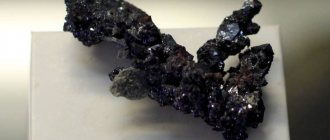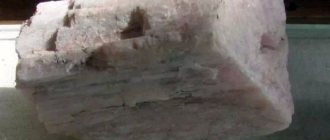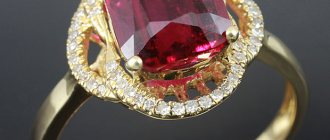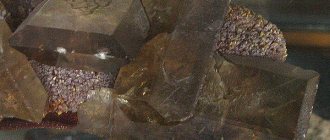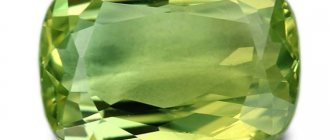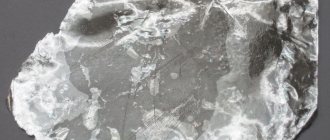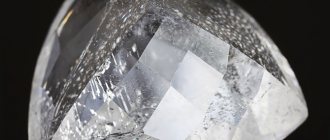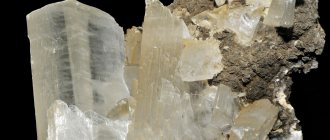From Greek, “peridot” means “bestower of abundance.” This is a semi-precious mineral. Among its other names you can find such as “olivine”, “peridot”, “forsterite” and “cashmere-peridot”. It is a silicate of magnesium and iron. The gem is endowed with healing and magical properties. Jewelry craftsmen use it to make expensive jewelry.
Origin of the stone
The history of peridot is comparable in age to the history of Ancient Egypt and the Mesopotamian kingdoms - it is also about 6,000 years old. The first of the deposits found (by the way, is still being developed) is located on the island of Zeberget in the Red Sea, which now belongs to Egypt.
Chrysolite
This stone was valued by the pharaohs of the “country of Kemet” and the high priests of ancient Judea. The golden-green gem was brought home from Palestine by European knights returning from the Crusades. The stone personified the playful and hot Middle Eastern sun, but at dusk, in the flickering light of tallow candles and splinters, the golden shine gave way to rich green, for which peridot received the name “evening emerald.”
The popularity of peridot periodically decreased and sometimes increased, but it never completely left the jewelry arena. Suffice it to say that a specially cut olive chrysolite adorns the Great Imperial Crown of the Russian autocrats. It weighs 192.75 carats and is incredibly expensive.
Peridot is one of the few semi-precious minerals that can be combined with gold and even diamonds, although only the best specimens are given this honor.
The origin of the “evening emerald” is either magmatic, like a diamond, or cosmic - it was found in meteorites that fell to Earth. Peridot was also discovered in soil samples taken on the Moon.
Peridot, aka olivine, aka peridot: a stone for good luck
Mineralogy is one of the most ancient sciences. Man's acquaintance with stone began at the dawn of our civilization, when primitive people began to use it as a tool and weapon. Then as a decoration for your body and decorative accessories, in the form of household items. The stone began to attract attention not only for its necessity, but also for its natural beauty, color, transparency and pattern. Our distant ancestors collected unusual stones, carefully stored them, and attributed properties to them based on their own observations and impressions. Thousands of years have passed since then, but the beauty of minerals still evokes delight, admiration and boundless interest.
Mentions of chrysolite are found in the Indian Vedas and in the first Christian books. It was known as a gemstone long before the new era, although it was often confused with other green minerals. In non-scientific literature and among collectors, the name “peridot” is still used to describe the light green demantoid garnet (“Ural emerald”). The mineralogical community will consider this name incorrect, gemologists will object to them: that’s what it was called for many centuries in a row. And what to do if they first named it, and only then determined the composition? This is how unscientific formulations took root: “Saxon peridot” for topaz, “aquamarine peridot” for beryl and “Brazilian peridot” for chrysoberyl.
Chrysolite has always been widely known and popular, which may have prompted traders and miners to deliberately or accidentally distort the names of other minerals in its favor.
In the legends of ancient times, when there was no clear classification of precious stones, even emeralds were mistaken for chrysolite. Chrysolite is an unusual, transparent stone of grassy-golden shades with unique properties. This mineral, emitting the light energy of spring, young grass and the sun, has long attracted people with its charm and incredible attractive power. Color saturation depends on the iron content. In the sun it takes on a golden hue, and in the shade it really looks like an emerald. The yellow tint goes away and pure green remains. Therefore, it is sometimes called the evening emerald.
The comparison to emerald was first attributed to it in ancient Rome. Historians have recorded many facts that when studying some ancient finds with emeralds, the latter actually turned out to be chrysolites.
For example, the chrysolite turned out to be a large green stone polished into a lens, known as the “Emerald of Nero.” Through this lens, like through binoculars, the bloodthirsty emperor watched gladiator fights and admired the glow over burning Rome, which he himself ordered to set on fire. Now the stone is kept “behind seven seals” in the Vatican treasury.
Chrysolite is the oldest name for the stone; it existed before our era and is translated from Greek as “golden stone”.
It is a noble variety of olivine formed due to magmatic crystallization. The bright shine of the stone is due to the high index of double refraction of light. Therefore, when a ray of sunlight hits a stone, it may create the impression of a double image. According to the Mohs hardness scale, the stone has a low value, no more than 6.5-7.0. Density - 3.3 g/cm3. Chemical composition: iron and magnesium orthosilicate. Chemical formula (Mg, Fe)2 SiO4.
Ancient Rome, Ancient Greece, and Ancient Egypt left quite a lot of references to this jewelry stone. There is a legend that peridot (peridot) was the favorite stone of the Egyptian queen Cleopatra. In European countries, the name of the stone is peridot, translated from Greek as “giving abundance.”
The most amazing thing is that peridot crystals are found not only on our planet, but also in the lunar soil; they are even contained in meteorites. Peridot crystals are short-columnar and prismatic, most often found in the form of flattened grains. Thus, in its origin, chrysolite can be not only volcanogenic, but also cosmogenic. It is characteristic of both deep magma and meteorite mass. This fact added mystery and mystery to the stone.
In Egypt, on the island of Zaberget in the Red Sea, there are the very first deposits of chrysolite. Now its largest developments are in the USA (Arizona, New Mexico) and Hawaii. There are deposits of this stone in Mexico, Brazil, Norway, South Africa, India, Burma and Tanzania. In Russia, chrysolites are mined in the Southern Urals, Murmansk region, Buryatia and Krasnoyarsk region.
Worship of rare, unusual stones is found in almost all peoples of the world. Shamans, sorcerers, and priests were the first to pay attention to the connection between man and stone. Random coincidences were filtered out through the filter of millennia and disappeared into oblivion. Only “working”, significant connections remained, firmly imprinted in the memory of mankind.
The first thing that immediately catches the eye of a natural scientist today is the dependence of the magical properties of the stone on the color and its intensity. Green, red, purple and blue stones have the most powerful effect on humans.
Scientists have found that the color of minerals is associated with the inclusion in its crystal lattice of ions, elements that can give up electrons with little external influence. As a result, structural disturbances occur in the crystal. Our little treasure “breathes”, lives its own inner life. Its external manifestations constitute a set of qualities that are traditionally called magical. Impurities of some metals have a particularly intense effect on the energy of the crystal. These are primarily iron, copper, manganese, chromium and lithium.
Transparent stones are capable of synchronously emitting light from the entire volume of the crystal in the form of a concentrated beam. This is laser radiation. The laser beam is invisible, it consists of waves that penetrate deeply into living tissue. It is likely that laser effects may be the source of many of the magical properties of stones.
To understand all this, you need to write a separate book and more than one. You need to have astrological and scientific knowledge, know the history of the ancient world and be able to recognize stones - in order to compare all the facts and provide accurate information on the influence of stones on human psychology. One thing has been reliably proven, and modern medicine takes into account this opinion, that if faith in amulets and talismans helps, then it must be strengthened. But faith, you know, is voluntary. And if you still have an interest in green, sunny chrysolite, which contains iron in its structure and has the ability to refract light twice, then from the next red line you will learn about its effect on humans, magical and medicinal properties obtained from the Internet by searching and with an eye to the credibility of the texts.
Since ancient times, people believed that the Sun endowed Chrysolite with a special powerful force that could protect against the influence of evil spirits, the evil eye and damage. It differed from other minerals in its strong energy. Ancient magicians wore amulets made of this stone, framing it in gold, which increased its magical power and capabilities. He helped them unravel the mysteries of the future and predict fate.
Traders in Ancient India carried it with them, considering peridot a stone of luck and good fortune. Businessmen of those times: merchants and merchants, were confident that the stone would help in concluding profitable deals and contracts, eliminate risk in financial transactions, and also help make profitable investments. They wore it without taking it off, as a talisman against all kinds of accidents, thefts and fires.
In the Middle Ages, peridot was a symbol of inspiration, as it was believed that the mineral had the ability to influence the creative abilities of the owner. In the 60s of the 19th century, the popularity of stone in France reached its apogee. Jewelry with peridot was held in high esteem not only for its extraordinary beauty and transparent golden hue. It was believed that the stone was a talisman that helped its owner resist temptations and protect him from rash actions. Thanks to its strong energy, peridot was revered by Catholic bishops; they still wear a ring with this stone as a symbol of spirituality, high morality and purity.
It is believed that chrysolite helps in all endeavors. Protects a person’s aura from any negative influence. If you give a stone figurine to newlyweds, they will be guaranteed a long and happy life, without quarrels and scandals. Peridot figurines and jewelry are given for wedding anniversaries, birthdays, and just for special occasions. A gifted stone has more power than one purchased independently. Jewelry with chrysolite is presented to young girls so that they can successfully arrange their destiny. Those who are constantly in sight are advised to always carry a peridot stone, earrings, necklace or ring (on the left hand) with them; it will protect its owner from envy and malice.
Astrologers believe that the stone’s properties are suitable for literally everyone. But chrysolite has some peculiarity; it is believed that this stone is monogamous. Once accustomed to a person, he reluctantly serves another, while trying not to get noticed or simply get lost. Therefore, purchasing jewelry with chrysolites at a pawnshop is not the best option.
The healing properties of the stone were discovered by the ancient Armenians; it was their healers who claimed that by gazing for a long time at the magical greenery of peridot, one could significantly improve one’s vision. One way or another, the color green has a beneficial effect on the heart, nervous system, and relieves mental stress. Motivates a person to overcome depression, become more active and relaxed.
I offer several photographs with jewelry made from this wonderful stone to check for yourself how true the statements of ancient healers were about the beneficial effects of chrysolite on humans.
It does not take a lot of time.
Enjoy watching 
If the publication captivated you a little and seemed useful to you, click “like” and “add to favorites.”
Thank you for your attention!
Best wishes 
Physicochemical characteristics
It is not entirely correct to talk about the physical properties of the chrysolite stone, since this word has historically been used to designate a whole group of greenish or yellow crystals, which includes topaz, chrysoberyl and even green Ural garnet. From a geological point of view, a true chrysolite is considered to be a colored variety of the mineral olivine. In scientific usage in English-speaking countries, it is also called peridot.
Chrysolite
Olivine, including green, yellow and olive, has a Mohs hardness of 6.5–7, acquires a glassy luster after polishing, and has a high refractive index of light rays - which is why diamond cuts are often used in relation to it. Despite this, olivine is fragile and subject to internal stress, so it breaks easily.
From a chemical point of view, it is magnesium and iron orthosilicate. Sometimes it contains small amounts of impurities of other substances - for example, mica. Its shine and transparency are glassy-oily.
| Formula | (Mg,Fe)2SiO4 |
| Color | Golden green in various shades of green |
| Shine | Glass |
| Transparency | Transparent |
| Hardness | 6,5-7 |
| Cleavage | Average in one direction |
| Kink | Uneven, conchoidal |
| Density | 3.2-4.3 g/cm³ |
Mining locations
In addition to the mentioned island of Zeberget (now called St. John's), peridot deposits are scattered throughout the world, but, as a rule, they are small. This mineral is rarely found on its own; it is mainly found together with diamonds in kimberlite pipes and diamond-bearing placers. Meteorite chrysolite is as rare as meteorites.
In Russia, “evening emerald” is mined along with diamonds in the mines of Yakutia, found in the Ural Mountains and in Kovdor, a small mountain range in the north of the Murmansk region. Kovdor gems are especially highly valued, since it is there that the highest quality specimens are found.
Abroad, the main deposits are also most often located side by side with diamond developments: they are in Tanzania and South Africa (South Africa), in Afghanistan and Sri Lanka, in Brazil and the USA. In the States, a large deposit of a particularly valuable variety - Messa chrysolite - is located in the state of Arizona, on the Apache Indian reservation. The development of this field is their “national business.”
Story
Peridot was mentioned in ancient manuscripts. Paracelsus noted that its green tints are useful for contemplation both for those with weak eyesight and for healthy people. At that time, its healing power was known, and the visual contact of its sparkling edges was pleasant to everyone.
This mineral has been known to mankind for about 4000 years, and in different eras its divine abilities and devilish influence have been discovered. Samples of peridot decorate the façade of Cologne Cathedral, which in the “dark ages” was interpreted as a devilish temptation.”
After the Crusades, warriors gave their wives jewelry with olivine.
Later, chrysolite served as decoration for the royal nobility. Only rich people could afford luxury sets.
There are memories of peridot in the Bible, where it was an element on the clothing of the high priests.
Many experts have noted that Emperor Nero looked at the fire in Rome precisely through this mineral.
Colors and varieties
The mineral chrysolite is a transparent, sometimes translucent (there is a slight haze) greenish-yellow stone. The golden hue is always present in it, the saturation of the green color varies depending on the chemical composition, viewing angle, lighting, etc. This is one of the few stones that “loves” artificial lighting - in its rays it most closely resembles a noble emerald.
Chrysolite
There is no clear color differentiation of subspecies. A particular stone may have a brownish, grassy, olive tint, or may be almost yellow. The most ancient specimens from the island of Zeberget were golden-green, with a hint of gold, which is why they received their name (“peridot” from ancient Greek - “stone of gold”). Now the grass-green and olive subspecies are most valued, as well as stones with light effects - asterism (“star-shaped” chrysolites), iridescence, “cat’s eye” effect, opalescent, and so on.
The cost of peridot greatly depends on its purity, size and weight. Large transparent stones, more than 1 cm in diameter, without cracks, chips or other defects, are rare. They are expensive and rightfully adorn the exhibitions of the world's leading museums. Specimens with minor defects are much more common; they are considered ornamental stones.
There are 2 main grades of quality stones: grade A - pure crystals without defects and without a brown tint in color, and grade B - all others, except those completely unsuitable for use in jewelry.
Medicinal properties
The properties of chrysolite in medicine are varied. Lithotherapists identify several areas in which wearing peridot is considered beneficial. This:
- neuralgic pain;
- headaches (except migraines);
- neuroses caused by stress - stuttering syndrome, nightmares and insomnia;
- hormonal fluctuations (stressful nature);
- blurred vision.
In the latter case, in order to slow down or stop developing myopia, lithotherapists advise simply looking at peridot for 20–30 minutes a day.
In addition to all of the above, some lithotherapists claim that olivine, carried with you or applied to a sore spot, relieves pain in cases of problems with the stomach, liver, kidneys and spine. It is also credited with the ability to relieve arrhythmia and normalize blood pressure.
Like some other stones, such as heliotrope, olivine is considered a detoxifier. To do this, some folk healers practice making “chrysolite water” - the stone is dipped into a vessel with water for a day, which then acquires beneficial properties.
Green peridot helps get rid of colds.
Peridot, crushed into powder, is included in some folk ointments for skin diseases - dermatitis of various natures and psoriasis.
Caring for olivine products
Peridot is a stone whose properties have made it a very popular material for making jewelry. Owners of olivine talismans are often interested in how to extend the life of their treasures.
Take proper care of your stone product.
- The mineral is quite hard, but it is still easy to break. Therefore, he needs protection from blows, falls and shocks.
- Do not wash peridot using household chemicals. The aggressive substances that are included in its composition can irreversibly damage the stone.
- The best way to clean the crystal is with regular soapy water and a soft brush.
- Peridot jewelry is best kept in a separate box, or at least wrapped in cloth.
He will certainly thank those owners who carefully look after their talisman. It will be much easier for them to establish a spiritual connection with the stone, and it will serve faithfully for many years.
Magical Features
In the world of magic, chrysolite is associated with two magical forces: the Sun, to which it is dedicated, and the element of Air. To some extent, this is a combination of Air and Fire, two mutually supporting forces. This is where the amazing combination of the basic magical properties of chrysolite comes from: protection from dark forces combined with attracting good luck.
Faceted peridot
First of all, it is a powerful amulet, capable of acting against creatures of the magical world, as well as protecting against random dangers of the physical plane, especially fires. Sorcerers and alchemists of the Dark Ages used chrysolite in a gold frame as an amulet that protected against evil spirits and evil spirits. In gold, it can even protect against hostile spells, damage, the evil eye and similar influences.
The silver setting gives the stone another ability - to protect against physical dangers. He was credited with the ability to deflect arrows and knives, giving the owner a bit of luck, necessary for both a magician and a warrior. Regardless of the frame, peridot had to be worn only on the left hand.
“Golden Stone” especially loves courts and litigation. It has long been considered the “stone of attorneys” - lawyers and notaries. Olivine was believed to help win even the most complex lawsuits. It also attracts good luck for bankers and moneylenders.
Chrysolite is luck in its material form.
Chrysolite
Among other things, this gem actively influences a person’s charisma in the direction of strengthening it. It helps the wearer to be liked by other people more, develops empathy (the ability to empathize), which allows you to successfully make new and restore lost connections. It is effective in any area where the result of any business depends on a person’s personal charm. The “Sun Stone” makes its owner “glow” like a star, which attracts other people to it.
For example, it can be successfully used to mutually pacify quarreling spouses - it will teach them to better understand each other.
Olivine also develops insight, intuition and, to some extent, precognitive abilities, if present initially.
It increases self-esteem - sometimes to the point of developing self-confidence.
Due to these properties, chrysolite is not recommended for wearing by people who initially have high self-esteem, who are inclined to influence the fate of others and try to decide other people's affairs at their own discretion. He is able to turn such people into tyrants and tyrants, who, in principle, are unable to listen to other people's opinions.
Peridot is also suitable for people who are planning to radically change their life. He helps them in their endeavors.
Interestingly, olivine is monogamous. It serves only one owner, the first and last. You cannot re-gift and sell (or buy second-hand - not in a store, but from the previous owner) jewelry with chrysolite - soon after this the stone may become cloudy, crack, or even get lost. In any case, he will lose his magical power.
Properties of peridot stone for zodiac signs
Peridot will add self-confidence to Pisces.
According to astrologers, peridot makes Pisces stand out. To them he reveals his full power. Pisces women should wear earrings with it. This way they will be able to find family happiness. If Pisces men constantly have a gem talisman with them, they will quickly build a career and achieve impressive results in their professional activities. Rings with peridot help maintain mutual respect and warm feelings. It also gives Pisces decisiveness. Their self-esteem increases, and their intellectual abilities develop.
The properties of peridot stone have a positive effect on the zodiac signs Leo and Virgo. They need to wear products or talismans made from it. Leos become even more self-confident. They gain loyalty and tolerance. Virgos reduce their excessive demands on others and get rid of excessive conservatism.
Peridot is suitable for Libra and Sagittarius. It is also worth purchasing for those born on the 3rd, 12th, 21st or 31st of each month. It is endowed with special power in October.
Each person decides for himself whether he should believe in the power of the gem. And anyone can experience its effects. Perhaps, with the help of peridot, it will be possible to solve all the difficulties and find the necessary solutions to the current circumstances. Even if it does not show its special qualities, it will certainly become a beautiful and inexpensive decoration.
Zodiac compatibility
Astrology is clear about this stone: most of all, according to the horoscope, it corresponds to Virgo, Pisces and Taurus, and to a lesser extent (oddly enough) to the fire signs - Leo and Aries. The worst combination of peridot jewelry is with the characters of Scorpio, Aquarius and Cancer. The meaning of the peridot stone for each of these signs is individual.
| Zodiac sign | Compatibility |
| Aries | + |
| Taurus | + |
| Twins | + |
| Cancer | + |
| a lion | +++ |
| Virgo | +++ |
| Scales | + |
| Scorpion | + |
| Sagittarius | + |
| Capricorn | + |
| Aquarius | + |
| Fish | — |
(“+++” – fits perfectly, “+” – can be worn, “-” – is strictly contraindicated)
Compatibility with other minerals
As an Air stone, olivine combines worst with stones of the Earth and Water elements, preferring proximity to gems dedicated to Air or Fire. This means that it can be worn:
- with diamond;
- coral;
- ruby;
- sapphire;
- rock crystal;
- amethyst;
- chrysoprase;
- carnelian;
- tourmaline;
- topaz.
Chrysolite
Mutual hostility and work “in opposition” to the “golden stone” is observed if it is worn at the same time:
- with sardonyx;
- obsidian;
- onyx;
- jasper;
- lapis lazuli;
- heliotrope;
- malachite;
- agate
Note that all of the above are opaque stones. They are considered to belong to the elements of Earth.
In addition, the playful and windy “sun stone” does not like Water; in combination with Water stones, it can cause a storm. Therefore, it should be worn with some caution:
- with emerald;
- moonstone;
- opal;
- aquamarine;
- pearls;
- alexandrite.
This does not mean that peridot cannot be used with the above-mentioned precious and semi-precious stones. It is not recommended to wear it for a long time or combine any of these stones with olivine in one product: the magical properties of the stone will weaken.
Interesting Facts
- Jewelers often treat peridot samples with colorless oils, waxes, natural or synthetic resins without adding hardeners under vacuum. All these procedures help improve the appearance of the stone. Cracks on its surface are filled with colorless substances with the addition of hardeners. After this, the stone becomes especially durable and strong.
- Peridot itself is practically not counterfeited, since it is widespread and inexpensive. But on its basis, reliable imitations of expensive emeralds are often made.
Scope of application
Colored olivine (peridot) is actively used in jewelry. Gold and silver jewelry is made with it: earrings, pendants, bracelets, pendants, brooches and rings.
Silver ring with chrysolite
They are also used without a frame, for example, to make beads and necklaces. Large stones with some effect, for example with a “cat’s eye” or iridescence, are used for inlaying luxury items - goblets, tiaras, figurines and other things. Large stones that have no jewelry value serve as raw materials for stone cutters. For example, they are often used to make small animal figurines.
The standard cutting methods for this semi-precious stone are diamond (57 facets), step, and emerald. For specimens with the cat's eye effect, a cabochon cut is used. The raw crystal also looks quite beautiful.
Deposits and processing of chrysolite
Egypt is considered the most important supplier. Peridot is mined on the uninhabited island of Zeberged, which is located in the very center of the Red Sea. Other countries where the gem is found:
- Russia (Yakutia, Murmansk, Krasnoyarsk);
- USA;
- Brazil;
- Pakistan;
- Tanzania;
- South Africa;
- Afghanistan.
Found chrysolites are sent to jewelers for processing. They are usually given a faceted shape (step, diamond, emerald cut). Specimens with the optical “cat’s eye” effect are cabochon cut. Gems are ground and polished. After this, they acquire a glassy, oily sheen.
Raw minerals are used to create jewelry.
Additionally, watch how an amateur finds similar stones:
How to distinguish a fake?
Despite the fact that artificial chrysolite is an impossible thing (laboratories that synthesize it do not exist in nature), there are many fakes made of plastic or colored glass on the market. You need to be especially wary of specimens that come from the island of Ceylon (state of Sri Lanka): part of the local population has begun to “produce” fake green stones, including chrysolites, from broken bottles. Shards of green bottle glass are immersed in the sea in the surf zone. After a few years, the waves roll them to such a state that the glass becomes like polished but uncut chrysolites.
Ring with peridot
Glass or plastic imitation is easily determined:
- firstly, it does not have the effect of dividing the sun's rays passed through it, as well as any other lighting effects;
- secondly, it quickly heats up from the warmth of your hands;
- thirdly, a fake “stone,” especially a plastic one, can be easily scratched.
You should be suspicious of large peridots, especially those sold at low prices. The price of a natural “sunstone” with a diameter of more than a centimeter cannot be less than $200, and not per stone, but only per carat (unit of mass). Large colored peridots are very rare in nature.
Another stone of a similar color and shade, only cheaper, for example, chrysoberyl, can also be passed off as chrysolite. But, unfortunately, this can only be determined by laboratory methods.
Care
Those who are interested in the properties of peridot and the zodiac signs that the stone is suitable for should also figure out how to care for such jewelry. Otherwise, any amulet can quickly fail. Proper care will extend the life of the amulet by several years.
Gem owners should consider several points:
- Despite its hardness, it can be broken. Therefore, at moments when the risk of damage increases, it is better to remove the amulet.
- Household chemicals have a destructive effect on the crystal. It contains aggressive components that can cause irreparable harm.
- The stone should be cleaned regularly using a light soap solution.
- Experts recommend storing the mineral separately from other jewelry.
Those who do everything for the amulet will be rewarded with their support and help. The connection with a caring owner is stronger. Therefore, the effect of using the crystal will be more noticeable.
How to wear and care
To fully reveal its magical properties, rings and bracelets with chrysolite are best worn on the left hand. Unlike other stones, there are no restrictions on wearing time. But there are requirements for the owner to be careful: this is a relatively fragile mineral that can be easily damaged.
You cannot store it in a box with stones of increased hardness, especially beryl and diamonds, as well as metal objects.
Brooch with chrysolite
You can wash jewelry with chrysolite with a weak solution of ammonia in water or wipe it with baking soda using a soft sponge. Before washing, you need to make sure that the stone in the jewelry is not secured with glue.
